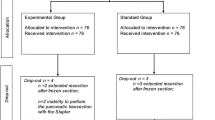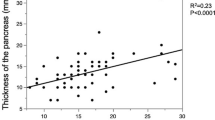Abstract
Background and aims
The operative mortality and morbidity associated with pancreatic surgery has been decreasing; however, pancreatic fistula remains a major cause of a potentially fatal complication. Although different devices and techniques have been proposed to reduce of the postoperative pancreatic fistula, none has gained unanimous acceptance. We herein describe a new technique for pancreatic transection using a sharp hook-shaped ultrasonically activated scalpel (UAS).
Materials and methods
Between December 2004 and June 2006, 32 patients who had undergone pancreatectomies performed using the sharp hook-shaped UAS (Ethicon Endo-Surgery, Cincinnati, OH, USA) were studied.
Results
The incidence of pancreatic fistula in these patients was 6.3% (2/32). Both cases underwent a distal pancreatectomy. No patient had systemic organ failure induced by postoperative pancreatic fistula, and conservative drainage management improved the pancreatic fistula. No pancreatic fistulas developed in patients who underwent pancreaticoduodenectomy with a duct-to-mucosa anastomosis pancreaticojejunostomy after pancreatic transection using the sharp hook-shaped UAS.
Conclusion
Pancreatic transection using the sharp hook-shaped UAS is an easy and useful method that facilitates detection of the main pancreatic duct with minimal blood loss. It may contribute to lower morbidity and mortality after pancreatic resection.


Similar content being viewed by others
References
Birkmeyer JD, Siewers AE, Finlayson EV, Stukel TA, Lucas FL, Batista I, Welch HG, Wennberg DE (2002) Hospital volume and surgical mortality in the United States. N Engl J Med 346:1128–1137
Okabayashi T, Kobayashi M, Nishimori I, Sugimoto T, Akimori T, Namikawa T, Okamoto K, Onishi S, Araki K (2006) Benefits of early postoperative jejunal feeding in patients undergoing duodenohemipancreatectomy. World J Gastroenterol 12:89–93
Payne RF, Pain JA (2006) Duct-to-mucosa pancreaticogastrostomy is a safe anastomosis following pancreaticoduodenectomy. Br J Surg 93:73–77
Suzuki Y, Fujino Y, Ku Y, Tanioka Y, Ajiki T, Kamigaki T, Tominaga M, Takeyama Y, Kuroda Y (2002) New pancreatic duct-invagination anastomosis using ultrasonic dissection for nonfibrotic pancreas with a nondilated duct. World J Surg 26:162–165
Kuroda Y, Tanioka Y, Suzuki Y, Ku Y, Saitoh Y (1995) Distal pancreatectomy using the ultrasonic dissector. J Am Coll Surg 180:737–738
Lin JW, Cameron JL, Yeo CJ, Riall TS, Lillemoe KD (2004) Risk factors and outcomes in postpancreaticoduodenectomy pancreaticocutaneous fistula. J Gastrointest Surg 8:951–959
Vasanjee SC, Bubenikb LJ, Hosgood G, Bauer R (2006) Evaluation of hemorrhage, sample size, and collateral damage for five hepatic biopsy methods in dogs. Vet Surg 35:86–93
Author information
Authors and Affiliations
Corresponding author
Rights and permissions
About this article
Cite this article
Okabayashi, T., Hanazaki, K., Nishimori, I. et al. Pancreatic transection using a sharp hook-shaped ultrasonically activated scalpel. Langenbecks Arch Surg 393, 1005–1008 (2008). https://doi.org/10.1007/s00423-007-0236-8
Received:
Accepted:
Published:
Issue Date:
DOI: https://doi.org/10.1007/s00423-007-0236-8




